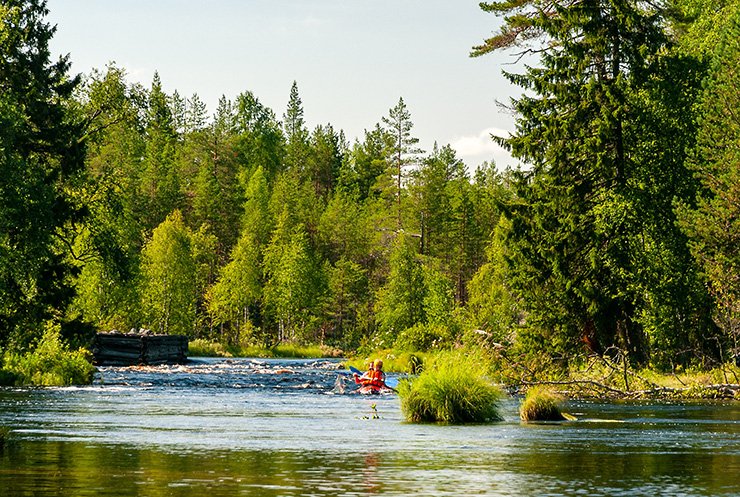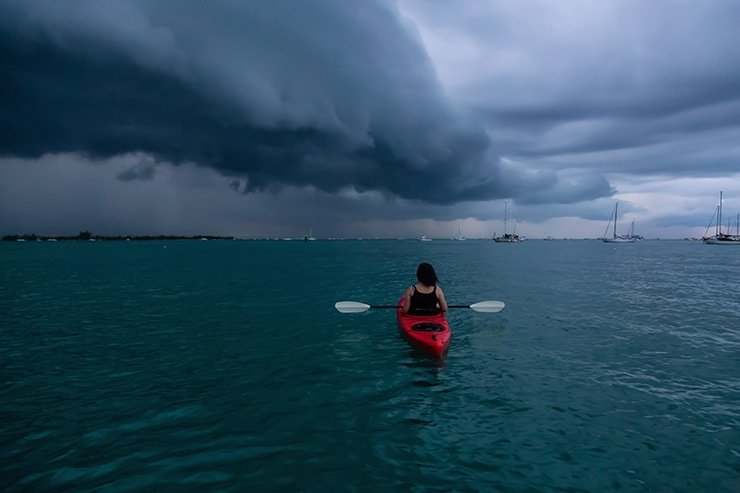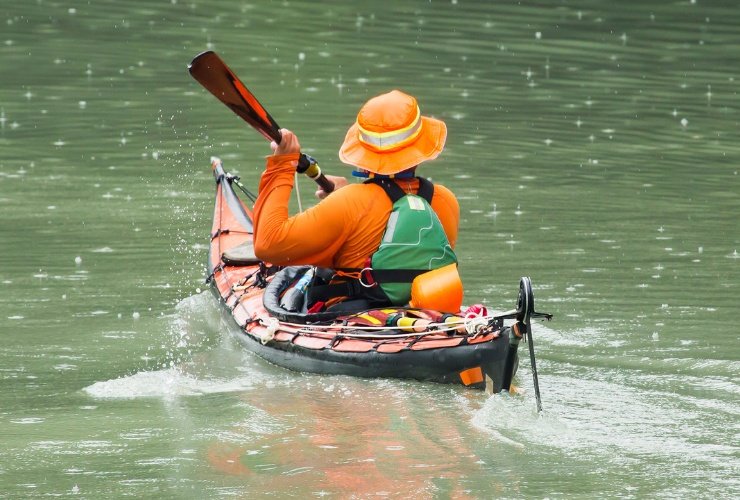Weather is one of those factors that can make or break a kayaking experience. However, a little understanding can go a long way toward enabling you to make the best of any given environment with little disruption.
This guide will cover all you need to know about optimal kayaking weather conditions and detail everything you’ll need to know to prepare you for any occasion.
Key Takeaways
- Good kayaking weather depends on wind speed and direction, water conditions, and atmospheric conditions.
- Wind speed of 10 knots or less is best. Ideally, you also want to paddle into the wind while going out and in the direction of the wind when coming back.
- Air and water temperatures of about 70 degrees are optimal for kayaking. Wear proper gear when kayaking in cold weather.
- Remember to check water conditions like waves, tides, currents, and flow rate. Don’t overestimate your skill level.
Good Weather for Kayaking Can Depend on Multiple Factors
Good kayaking weather depends mainly on the following factors:
- Wind speed and direction – How hard is the wind blowing, and where it’s coming from.
- Water conditions – This includes the temperature, how calm or active the water is etc…
- Atmospheric conditions – This includes all the weather around you – including heat or precipitation/rain; it can be easy to overlook this and just focus on the wind and water.
Out of all the conditions listed above, the wind is the one you’ll want to pay attention to first.
Optimum Wind Speed and Direction
The wind conditions have by far the most significant effect on any kayaker – wind speeds that are too high will make paddling much more strenuous, thus tiring you out faster.
If you plan to make a long trip, this is something to watch out for – you may find yourself alarmingly tired and realize it’s due to the extra demand of paddling against a strong wind.
Now, theoretically, the best conditions for kayaking are minimal wind, but depending on where you live, you’re unlikely to have perfect wind conditions.
Wind direction tends to follow regional patterns that can change with seasons, and you can use this to plan your trips so you have minimal wind or even a boost pushing you out and minimal or no wind on the way back in.
In vain of that, there are things you can watch out for.

A Wind Speed of 10 Knots or Less is Optimal
Kayaking is not sailing – the answer to “how much wind is best?” is always zero, a gentle breeze at a close second (and high winds certainly aren’t preferable).
However, there is a wind speed range beginners should look for – 10 knots or less, and you’ll be fine. Once you get higher than that, you will feel the strain.
For veterans/advanced paddlers, you’ll want to look for 20 knots or less.
While it’s possible to kayak in higher wind speeds, it will be more difficult, and if you’re planning for a long session, it can become truly exhausting paddling against strong winds.
ALSO READ: How much wind is too much for kayaking?
Use Wind Direction to Your Advantage
While there isn’t an ideal wind direction, you can understand where the wind usually flows in your local area to plan your routes.
It’s nearly always better to paddle against the wind as you start your journey and have the wind at your back on the return.
You’re always stronger or fresher at the start of a journey, and it’s generally more pleasant to make the return journey assisted by the wind rather than fighting against it.
However, the weather is fickle, and this goes double for the wind; so take this knowledge but also remember that wind can and will suddenly change.
The Best Temperatures for Kayaking

Most of the time, when referring to temperature, it usually means avoiding water that’s too cold. Water below 70 Fahrenheit should be treated with caution – even the hardiest kayakers will need to look at proper winter gear to kayak in temperatures lower than this. Seriously, the right gear can make all the difference!
That said, there is a quick rule of thumb you can follow to work out if the water temperature is ok.
The 120 Rule for Water Temperature
The 120 degrees rule is where you take the temperature of the water and the air temperature, and if they add up to at least 120 degrees, then it should be relatively comfortable to kayak. Also, if you’re wearing the right gear, the water temperature may not matter so much.
- Data on water and air temperature in your area can usually be found online; other than that, ask an experienced kayaker what the off-season is like.
- It’s fair to say that some kayakers will paddle year-round in icy conditions, but you need to wear the right gear; a wet suit may or may not be adequate protection (that depends on how cold water in your area can get).
- You can get a cold shock fast if you fall into dangerously cold water and aren’t prepared for it.
Air Temperature Above 70 is Optimal for Kayaking
Air temperatures above 70 degrees make things comfortable and easier when applying the 120 rule.
In general, anything over 50 degrees will tend to make for comfortable kayaking (while it’s nice to know what the best weather is, it will fluctuate all over the place).
You always want to focus more on water temperature than air temperature since cold water can shock your body in a way that air can’t. You can’t gauge what water will feel like based on air temperature, so be sure to check water temperatures too.
Work With The Waves, Tides, and Currents

The secret to excellent kayaking is understanding water – and nowhere does this pay off more than understanding the tide.
One good rule of thumb is always to plan your trip so that you’re not fighting against the tide on the way back to shore (just like with the wind).
Tidal patterns will vary across terrain and location; rivers will follow their own currents, and the ocean sticks to its inward and outward tide. Once you know what the patterns are for your local area, you’ll be set.
Optimal Wave Heights for Kayaking
Wave height depends on your goals and experience level – a veteran paddle may handle 2-foot waves with no problem, but a beginner might not find this to be safe kayaking conditions; they may struggle and get capsized by the same wave.
If you’re a newbie, then a good rule of thumb is to stick to waves under a foot or small waves (around 30cm). However, it can be hard to gauge wave height accurately in the field, so if you’re a beginner and a wave looks too big, follow your gut.
Always Consider Flow Rates (if Whitewater Kayaking)
If you’re doing whitewater kayaking, one thing to consider is flow rate. However, don’t judge solely by flow rate; it’s never a good idea. You should ask for detailed information about any river you plan to go on.
- The flow rate of a river is measured in Cubic Feet Per Second (CFS).
- Generally, a higher CFS indicates a faster-flowing river.
- However, there’s more to it than that – a smaller river with a higher CFS will be much faster than a larger one with the same CFS.
This is why getting to know a river before you do any whitewater kayaking is so important. Some whitewater kayakers may also be familiar with the F-O-G acronym. This stands for Flow, Obstacles, and Gradient.
An F-O-G ranking generally dictates how difficult a river will be – so it’s good to get to grips with this concept if you’re planning on tackling any rivers. The best weather conditions in the world won’t help if you’re paddling rivers that you can’t handle!
Important Factors to Consider When Assessing The Conditions

There are some things to remember when looking at weather forecasts and assessing conditions.
Getting accurate data and information about the water and wind forecast is always a good idea. There is a huge difference between what the numbers can tell you vs. actual experience in the local environment.
Remember, Not All Waterways Are the Same
As mentioned, not all things are of equal importance in different waterways. For example, if you’re kayaking on the sea, you’re going to want to pay special attention to the wind.
Wind conditions drastically affect the sea; strong winds can blow you entirely off course and potentially out to sea!
Whereas on a river, you aren’t going to pay as much attention to the wind because if it does pick up, you can dock more easily.
Dressing for The Conditions is Crucial
Proper clothing is essential. It’s what allows you to withstand weather that isn’t ideal.
When beginners start kayaking, one of the most forgotten-about things is adequate sun protection. Water reflects UV rays much more potently, so you need some UV protection even in cloudy weather.
Kayaking in Cold Weather
The main danger of cold weather kayaking is hypothermia – depending on how cold it gets in your area, you’ll need to take steps to protect yourself.
Here are some clothing options for cold weather (you may or may not need all of these):
- A wetsuit will offer great protection from cold weather and water.
- Wool socks and waterproof paddling boots will keep your feet warm.
- Good quality wool or neoprene gloves will protect your fingers.
- Outer layers that protect you from the wind.
- A spare set of dry clothes (inside a dry bag) for later
Kayaking in Hot Weather
Sunstroke (or heat stroke) is the main danger with warm weather kayaking. Warm weather conditions can be just as harmful as low temperatures the recommendations, especially coupled with strenuous activity if you don’t have adequate sun protection. Just like with cold weather conditions, check the forecast before you go out (and the UV index too). Also, be sure you’re wearing the right clothing for warm weather conditions:
- Dry Tops (waterproof cagoules)
- Sun cap or wide-brimmed hat
- Sunglasses
- White long-sleeved top (to protect against UV rays)
Check The Weather, and Check it Again

Weather factors are nearly always changing. You want to get into the habit of regularly checking the weather forecast for your area; this will also build your knowledge of the conditions you can expect over time – and you can avoid accidentally paddling out in bad weather conditions.
- Check the forecast throughout the day, as it will change. Make a habit of double-checking (look at the marine forecasts if you’re paddling the ocean, too)
- Look for wind conditions that are decreasing in the forecast or “calm,” “light air” or “light breeze.”
- When kayaking in larger water bodies, check for information about water and air temperatures (and then apply the 120 rule).
- Clouds signify shade for a sunny day or a potential brewing storm.
There are so many good apps out there that can give you accurate and up-to-date information about the weather – here are a few:
- NOAA Weather Radar
- Tide Charts Near Me
- AccuWeather
- Navionics mobile app
Never Forget Basic Safety Supplies
As always, even in ideal weather conditions, you’ll want to have the essential supplies that will aid you on any kayaking journey and help you withstand the elements:
- PFD (Personal Flotation Device)
- Sunscreen
- Snacks
- Water
- Signaling whistle
- Spray skirt
Conclusion
You can’t change the weather, but with a bit of understanding, you can make the most of any environment and get the best out of any kayaking session you go on. Getting into the habit of checking weather and water conditions builds invaluable knowledge and is all part of becoming a better kayaker.
Thank you for reading, if you liked this guide on weather conditions, please like, comment, and share with your kayaking buddies.

